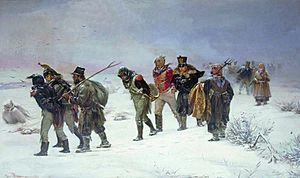Withdrawal (military) facts for kids
A military withdrawal or retreat is when an army or group of soldiers moves back from a fight or a position. It's like pulling back your team while still keeping an eye on the other side. Armies might retreat for different reasons. They might want to move to a place that's easier to defend, or maybe they're trying to trick the enemy into a trap. Sometimes, they just need to move away quickly to save their soldiers from being defeated.
Moving back can be risky. Soldiers need to stay organized and disciplined so that a retreat doesn't turn into a complete mess, called a rout. It's also important that a retreat doesn't make the soldiers lose their courage or belief in their mission.
Contents
Why Armies Retreat
Sometimes, an army has to pull back because they are outnumbered or in a bad spot. But even when retreating, they often try to hurt the enemy as much as possible.
Slowing Down the Enemy
To slow down an enemy, a retreating army might use different tricks:
- They might set up hidden mines or booby traps.
- A small group of soldiers might set an ambush to surprise and delay the enemy.
- They could lead the enemy into areas where their own artillery (big guns) can fire on them.
- They might use "scorched earth" tactics, which means destroying anything useful (like food or buildings) so the enemy can't use it.
What is a Rout?
In a war, the main goal is to defeat the enemy. One way to do this is to make their army lose hope and run away from the battlefield. When an army becomes completely disorganized, it can no longer fight as a team. The winning side can then chase the fleeing soldiers, trying to capture them or cause more damage.
However, a commander must be careful. Sometimes, an enemy might pretend to retreat to trick you. This is called a "feigned retreat."
Tricking the Enemy: Feigned Retreats
A "feigned retreat" is when soldiers pretend to run away to trick the enemy. They want to lure the enemy away from a strong position or into a trap. This is a very old trick that has been used in wars for a long time.
Here are two famous examples:
- William the Conqueror used this trick during the Battle of Hastings in 1066. His soldiers pretended to run away, and many of the English soldiers followed them down from their strong position on a hill. When the English were in the open, William's fast cavalry (soldiers on horseback) turned around and attacked them, defeating them.
- The ancient Mongols were very famous for using feigned retreats. Their fast, light cavalry could easily outrun any enemy trying to chase them. In the middle of a battle, the Mongol army would sometimes pretend to be tired or confused and suddenly ride away. The enemy, thinking they had won, would chase them. As the Mongols rode away, they would fire arrows backward at their pursuers (this was called a "Parthian shot"). When the enemy stopped chasing, the Mongols would turn around and charge, usually winning the fight. They used this trick to break larger armies into smaller groups that were easier to defeat.
Leaving Occupied Lands
Sometimes, soldiers leave a place they have been occupying for political reasons, not because of a fight. This is called an "occupied withdrawal." It happens when there is a ceasefire (a stop to fighting) or during a time of peace. For example, this has happened in places like Palestine, where troops have pulled back from areas they once controlled.
Images for kids
See also
 In Spanish: Retirada para niños
In Spanish: Retirada para niños



